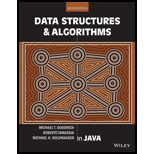
Explanation of Solution
The algorithm to concatenate two doubly linked list “L” and “M” into single list “L'” is given below:
Algorithm:
Input: Two doubly linked list “L” and “M”.
Output: Concatenate the two doubly linked lists into single list “L'”.
Concatenate(L, M):
//Create new nodes
Create a new node "n" and "v"
/*Get previous node for trailer of list "L" using getPrev() method and assign into "n". */
n = (L.getTrailer()).getPrev()
/*Get next node for header of list "M" using getNext() method and assign into "v" */
v = (M.getHeader()).getNext()
// Set next node for header of list "M" as "null"
(M.getHeader()).setNext(null)
//Set previous node for trailer of list "L" as "null"
(L.getTrailer()).setPrev(null)
/*Call setNext() method by passing the "v" node to set the next node as "v". */
n.setNext(v)
/*Call setPrev() method by passing the "n" node to set the previous node as "n". */
v.setPrev(n)
//Assign the concatenated list into single list "L'"
L' = L
/*Set trailer for list "L'" by calling setTrailer() method by passing parameter as "trailer of list "M"...
Want to see the full answer?
Check out a sample textbook solution
Chapter 3 Solutions
Data Structures and Algorithms in Java
- Dijkstra's Algorithm (part 1). Consider the network shown below, and Dijkstra’s link-state algorithm. Here, we are interested in computing the least cost path from node E (note: the start node here is E) to all other nodes using Dijkstra's algorithm. Using the algorithm statement used in the textbook and its visual representation, complete the "Step 0" row in the table below showing the link state algorithm’s execution by matching the table entries (i), (ii), (iii), and (iv) with their values. Write down your final [correct] answer, as you‘ll need it for the next question.arrow_forward4. |z + 5 - 5i| = 7arrow_forward14. dz, C: |z❘ C: |z❘ = 0.6 ze² - 2iz Harrow_forward
 C++ Programming: From Problem Analysis to Program...Computer ScienceISBN:9781337102087Author:D. S. MalikPublisher:Cengage Learning
C++ Programming: From Problem Analysis to Program...Computer ScienceISBN:9781337102087Author:D. S. MalikPublisher:Cengage Learning New Perspectives on HTML5, CSS3, and JavaScriptComputer ScienceISBN:9781305503922Author:Patrick M. CareyPublisher:Cengage Learning
New Perspectives on HTML5, CSS3, and JavaScriptComputer ScienceISBN:9781305503922Author:Patrick M. CareyPublisher:Cengage Learning Systems ArchitectureComputer ScienceISBN:9781305080195Author:Stephen D. BurdPublisher:Cengage Learning
Systems ArchitectureComputer ScienceISBN:9781305080195Author:Stephen D. BurdPublisher:Cengage Learning EBK JAVA PROGRAMMINGComputer ScienceISBN:9781337671385Author:FARRELLPublisher:CENGAGE LEARNING - CONSIGNMENTProgramming Logic & Design ComprehensiveComputer ScienceISBN:9781337669405Author:FARRELLPublisher:Cengage
EBK JAVA PROGRAMMINGComputer ScienceISBN:9781337671385Author:FARRELLPublisher:CENGAGE LEARNING - CONSIGNMENTProgramming Logic & Design ComprehensiveComputer ScienceISBN:9781337669405Author:FARRELLPublisher:Cengage C++ for Engineers and ScientistsComputer ScienceISBN:9781133187844Author:Bronson, Gary J.Publisher:Course Technology Ptr
C++ for Engineers and ScientistsComputer ScienceISBN:9781133187844Author:Bronson, Gary J.Publisher:Course Technology Ptr





